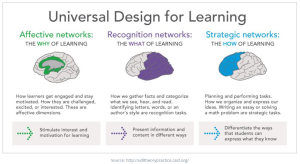4 Universal Design for Learning
Universal Design for Learning (UDL) is an educational framework that aims to improve and optimize teaching and learning for all people based on scientific insights into how humans learn. UDL provides a blueprint for creating instructional goals, methods, materials, and assessments that work for everyone, accommodating individual learning differences.
Key Principles of UDL

- Multiple Means of Engagement: This principle focuses on stimulating students’ interest and motivation for learning in diverse ways. It involves offering various ways to engage learners to keep them interested and motivated. This can include choices in content, tools, and learning contexts, as well as incorporating activities that are relevant and meaningful to them.
- Multiple Means of Representation: This principle involves presenting information and content in multiple ways to ensure that it is accessible to all learners. This could include using different media (text, audio, video), providing summaries and highlights, and offering translations or adaptations for students with different language or sensory needs.
- Multiple Means of Action and Expression: This principle focuses on allowing students to demonstrate what they know in various ways. It emphasizes offering different ways for students to express their knowledge and skills, whether through writing, speaking, drawing, or using technology.
Universally Designed Assessments
Designing assessments universally ensures that every student, regardless of their background or learning needs, has equitable access to demonstrate their knowledge and skills. By incorporating features such as clear instructions, alternative formats, and multiple means of response, universally designed assessments accommodate a diverse range of learners, including those with disabilities or English language learners. This approach promotes equity and inclusivity in the classroom, fostering a sense of belonging and valuing each student’s unique strengths. Universality allows for differentiation, supporting personalized learning and helping students reach their full potential. By aligning with legal requirements and ethical principles, universally designed assessments ensure fairness and nondiscrimination in education.
The chapter Introduction to Universally Designed Assessments is a great place to begin to learn about the importance of creating assessments that are accessible and inclusive for all learners. It highlights the principles of universal design for learning (UDL) as a framework for designing assessments that accommodate diverse learners’ needs.
The National Center of Educational Outcomes states that there are 7 elements of universal design of assessments (UDA):
- Inclusive assessment population
- Precisely defined constructs
- Accessible, non-biased items
- Amenable to accommodations
- Simple, clear, and intuitive instructions and procedures
- Maximum readability and comprehensibility
- Maximum legibility
| Tips for Designing Assessments (adapted from altLab, 2022) |
|
When designing assessments using UDL, accessibility is inherently integrated into the assessment process, ensuring that all students, regardless of their abilities or learning preferences, can fully participate and demonstrate their understanding. By incorporating UDL principles into assessment design, educators create assessments that are flexible, equitable, and inclusive, thereby removing barriers to learning and allowing every student to succeed.
Student Accommodations
The University of Saskatchewan has outlined Accommodations for Students to ensure that all students needs can be met and recommend the following suggestions as accommodations:
- Consider screen time for students when designing assessments, assignments, and class activities.
- Provide options for demonstrating learning and vary submission formats.
- Be mindful of deadlines and the volume of assigned material.
- Allow asynchronous discussion postings to accommodate different student schedules and needs.
- Acknowledge technology limitations and provide alternatives for participation.
- Ensure clarity in live discussions for students using assistive technology.
- Offer downloadable materials for assessment to accommodate diverse learning needs.
- Create accessible assessments by using headings, alt text for images, and readable fonts.
- Communicate with students individually to identify specific accommodations needed.
- Allow flexible deadlines or extended time for assessments.
- Offer options for submitting assessment(e.g., email, online platforms, in-person).
- Implement closed captioning or transcripts for audiovisual content.
- Utilize screen reader-compatible platforms and ensure compatibility with assistive technologies.
- Provide clear and accessible instructions for navigating the assessment.
- Provide alternative formats for assessment (e.g., text transcripts for videos, accessible PDFs for documents).
Additionally, you can guide students to the University of Saskatchewan’s Access and Equity page, where they can find comprehensive resources and support services tailored to their individual accommodation needs. This page provides information on available accommodations, how to request them, and contact details for accessibility services staff who can offer personalized assistance and guidance. By accessing these resources, students can ensure they receive the necessary support to thrive in their academic pursuits.
